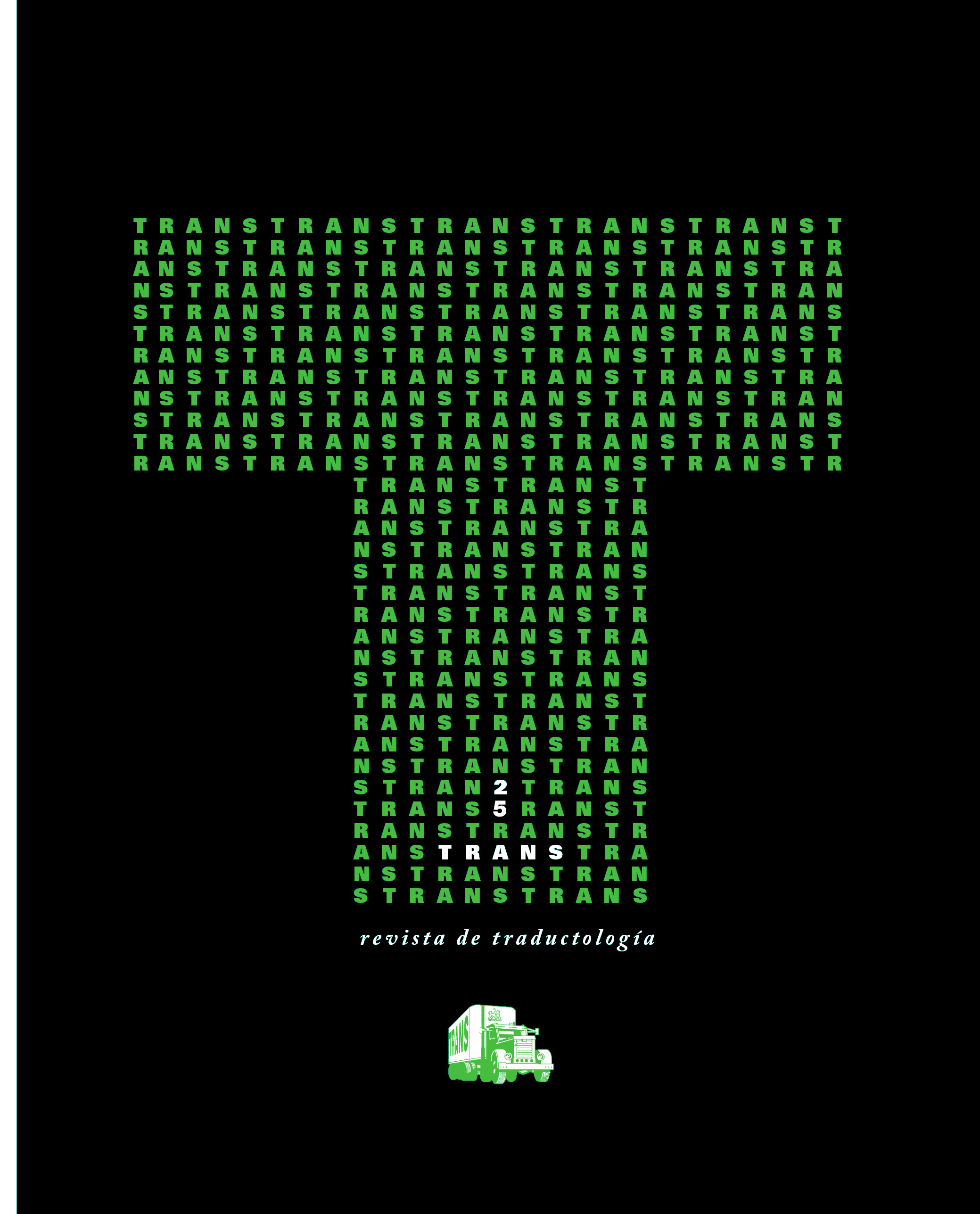“Dándole a la pluma”: the reception of Winesburg, Ohio (Sherwood Anderson, 1919) in Spain through its translations
DOI:
https://doi.org/10.24310/TRANS.2021.v1i25.10072Keywords:
pretranslation, sociology of translation, aesthetics of reception, translative analysis of literary texts, twentieth century American literatureAbstract
A literary author’s reception through translation is characterized by the sociology of the translational phenomenon. The preponderance of a specific aesthetic canon and the revolution in reading habits are a faithful reflection of the cultural paradigms in force in the target culture over a period of time, a question which conditions the nature of the translations published and, moreover, the need for new translations. There are also questions intrinsically related to translational reality which influence this process such as market requirements.
This article seeks to analyse the reception of Sherwood Anderson’s Winesburg, Ohio (1919) in Spain through the aforementioned theoretical perspectives. The study pays particular attention to the publishing history of its translations, along with the linguistic characteristics of the first translation (1932) in comparison to the latest Spanish version of the book (2016).
Downloads
Metrics
Publication Facts
Reviewer profiles N/A
Author statements
Indexed in
-
—
- Academic society
- N/A
- Publisher
- Universidad de Málaga
References
BAKER, M. (1992). In Other Words. A coursebook on translation, London: Routledge.
BERMAN, A. (1991): «La retraduction comme espace de la traduction», en Retraduire. Palimpsestes, nº 4, 1990, Paris : Publications de la Sorbonne Nouvelle, 1-7.
BRIZ, A. y VALESCO, GRUPO (2000): Cómo se comenta un texto coloquial, Barcelona: Ariel.
CADERA, S. (2017): «Literary Retranslation in Context: a Historical, Social and Cultural Perspective», en y CADERA, S. WALSH, A. (EDS.) (2017): Literary Retranslation in context, Bern: Peter Lang, 5-18.
CHESTERMAN, A. (1997): Memes of Translation, Amsterdam: Benjamins.
DEANE-COX, S. (2014): Retranslations, translation, literature, and reinterpretation, London: Bloomsbury.
DÍAZ, M. E. (1990): «Introducción» a Anderson S.: Winesburg Ohio, trad. de Armando Ros, Madrid: Cátedra.
EVEN-ZOHAR, I. (1990): «The Position of Translated Literature within the Literary Polysystem», en Poetics Today, 11:1, 45-51.
GAMBIER, Y. (1994): «La rétraduction: retour et détour», en Meta, vol. 39, nº. 3, 413-417.
GOYTISOLO, J. (1959): Problemas de la novela, Barcelona: Seix Barral.
GUTIÉRREZ ÁLVAREZ, P. (2015) : «Fontamara: una editorial marxista revolucionaria», en Kaosenlared, 14 de marzo [Procedente de: https://kaosenlared.net/fontamara-una-editorial-marxista-revolucionaria/].
GUZMÁN MORA, J. (2019): «Armando Lázaro Ros : una reconstrucción bibliográfica», en Lectura y signo, núm, 14, 7-33.
HERMANS, T. (2007): «Translation, irritation and resonance», en WOLF, Michela y FUKARI, Alexandra (eds.) (2007): Constructing a Sociology of Translation. Amsterdam, Philadelphia: Benjamins, 57-75.
ISER, W. (1989): «La estructura apelativa de los textos», en Rainer Warning, (ed.): Estética de la recepción, trad. de Ricardo Sánchez Ortiz de Urbina, Madrid: Visor.
KOCH, P. y OESTERREICHER, W. (2007): Lengua hablada en la romania. Español, francés, italiano, trad. esp. de Araceli López Serena, Madrid: Gredos.
LAKOFF, R. T. (1993): «Some of My Favorite Writers are Literate: The Mingling of Oral and Literate Strategies in Written Communication», en TANNEN, D. (ed.): Spoken and Written Language. Exploring Orality and Literacy, Norwood (New Jersey): Ablex Publishing Corporation.
LEFEVERE, A. (ED.) (1992): Translation, Rewriting & Manipulation of Literary Fame, London: Routledge.
LEUVEN-ZWART, K. M. VAN (1989) : «Translation and Original: Similarities and Dissimilarities I», en Target 2:1, 151-181.
LEUVEN-ZWART, K. M. VAN (1990) : «Translation and Original: Similarities and Dissimilarities II», en Target 2:1, 69-95.
LOTMAN, I. (1978): Estructura del texto artístico, trad. de V. Imbert, Madrid: Istmo.
LOTMAN, I. (1996-1998): La semiosfera I y II, trad. de D. Navarro, Madrid: Cátedra.
MORET, X. (2002): Tiempo de editores. Historia de la edición en España (1939-1975), Barcelona: Destino.
MORTARA, B. (1991): Manual de retórica, trad. de María José Vega, Madrid: Cátedra.
NORD, C. (1991): Text Analysis in Translation, Amsterdam-Atlanta: Rodopi.
ORTIZ GOZALO (2007): «La retraducción en el panorama de la literatura contemporánea», en ZARO, J. J. y RUIZ NOGUERA, F. (eds.): Retraducir: una nueva mirada, Málaga: Miguel Gómez Ediciones, 35-48.
PEÑA, L. (2010): En minoría de a uno: la historia de mis ideas y de mis hechos, autoedición. [Procedente de:
TWOMEY, L. A. (2003): La recepción de la narrativa de Ernest Hemingway en la posguerra española. Memoria para la obtención del Grado de Doctor, Madrid: Universidad Complutense.
VENUTI, L. (1995): The Translator’s Invisibility. A History of Translation, London: Routledge.
VENUTI, L. (2004): «Retranslations: The Creation of Value», en Faull, K. M. (ed.): Translation and Culture, Lewisburg: Bucknell University Press, 25-38.
VÁZQUEZ, J. (2018): «Sandra Ollo, editora de El Acantilado: “Si resucitara Stefan Zweig, le diría: ‘Siéntese y hablemos”’», El Mundo, 27 de abril [procedente de: https://www.elmundo.es/papel/cultura/2018/04/27/5ae1eef746163f8d168b45be.html
Downloads
Published
How to Cite
Issue
Section
License
All contents published in TRANS. Revista de Traductología are protected under the Creative Commons Attribution-NonCommercial-ShareAlike 4.0 International (CC BY-NC-SA 4.0) license. All about this license is available in the following link: <http://creativecommons.org/licenses/by-nc-sa/4.0>
Users can copy, use, redistribute, share and exhibit publicly as long as:
- The original source and authorship of the material are cited (Journal, Publisher and URL of the work).
- It is not used for comercial purposes.
- The existence of the license and its especifications are mentioned.
- ShareAlike — If you remix, transform, or build upon the material, you must distribute your contributions under the same license as the original.
There are two sets of authors’ rights: moral and property rights. Moral rights are perpetual prerogatives, unrenounceable, not-transferable, unalienable, imprescriptible and inembargable. According to authors’ rights legislation, TRANS. Revista de Traductología recognizes and respects authors moral rights, as well as the ownership of property rights, which will be transferred to University of Malaga in open access.
The property rights are referred to the benefits that are gained by the use or the dissemination of works. TRANS. Revista de Traductología is published in an open access form and it is exclusively licenced by any means for doing or authorising distribution, dissemination, reproduction, , adaptation, translation or arrangement of works.
Authors are responsable for obtaining the necessary permission to use copyrighted images.













21.png)
